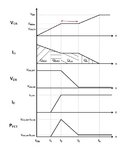cmos_ajay
Full Member level 2
Hi,
Attached is a waveform of a power MOSFET turn on procedure.
* I would like to know why the Cgs ( gate source capacitance) has a constant voltage across it during time interval T2 to T3 ?
* Why does Cgs 'not' charge during T2 to T3 ?
This is called as a Miller plateau region, but the text book explanation is not clear to me.
Can someone explain ??
Attached is a waveform of a power MOSFET turn on procedure.
* I would like to know why the Cgs ( gate source capacitance) has a constant voltage across it during time interval T2 to T3 ?
* Why does Cgs 'not' charge during T2 to T3 ?
This is called as a Miller plateau region, but the text book explanation is not clear to me.
Can someone explain ??
